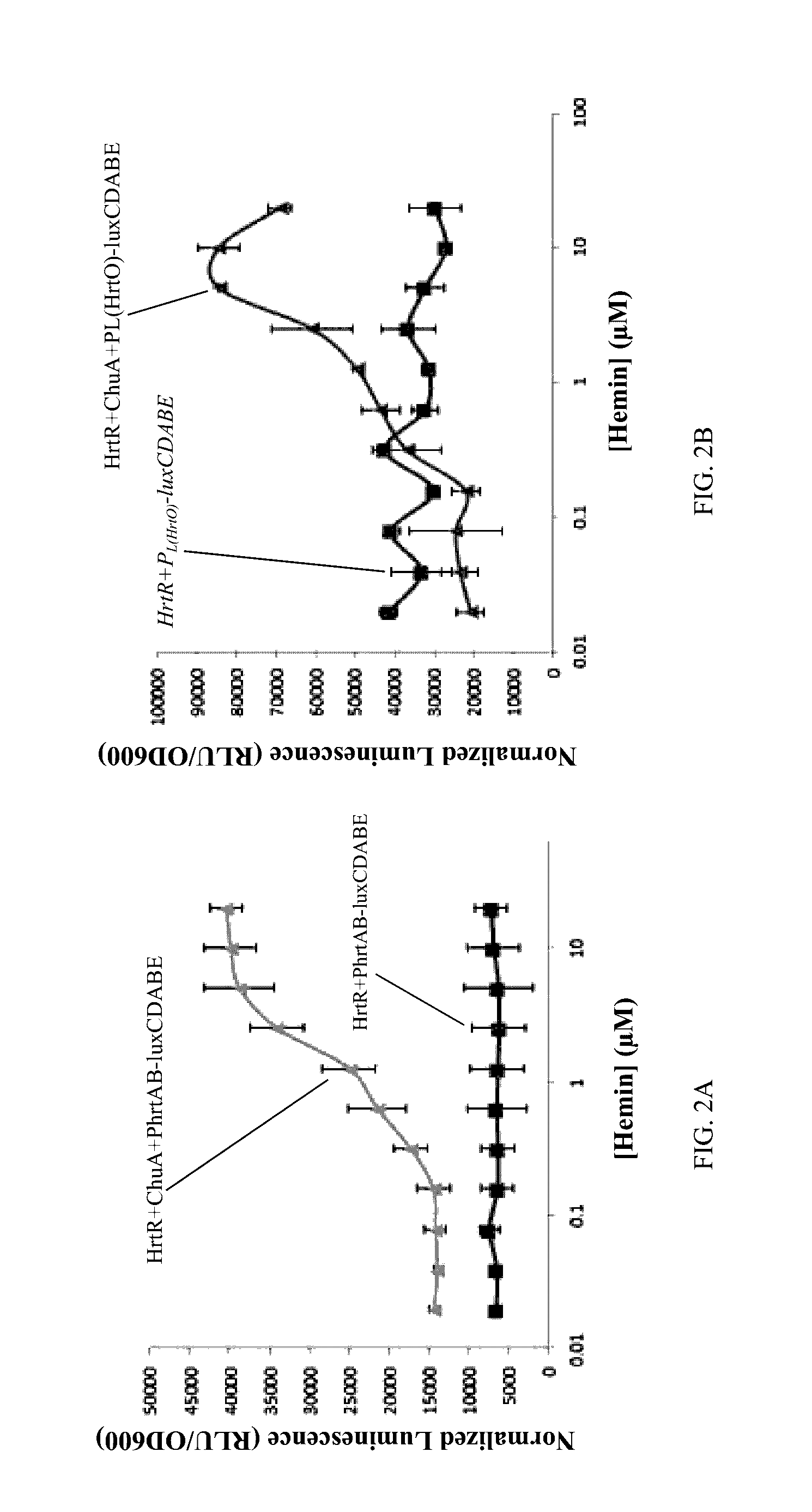Genetically engineered sensors for in vivo detection of bleeding
a technology of in vivo detection and gene engineering, applied in the field of biosynthetic engineering of microorganisms, can solve the problems of false positives of dietary peroxidases (e.g., vitamin c)
- Summary
- Abstract
- Description
- Claims
- Application Information
AI Technical Summary
Benefits of technology
Problems solved by technology
Method used
Image
Examples
example 1
Engineered Synthetic Gene Circuits in Escherichia coli for Autonomous in Vivo Sensing of Blood
Engineered Microorganisms
[0084]An Escherichia coli MG1655 strain was engineered to sense sub-micromolar levels of hemin using the Lactococcus lactis heme-responsive transcription factor HrtR in conjunction with the E. coli outer-membrane heme transporter ChuA (FIG. 1). Naturally-occurring in Lactococcus lactis, HrtR is a TetR-family transcriptional repressor that tightly binds to cognate HrtO operator sites, thereby preventing transcription of the heme exporter HrtAB. In the presence of heme, HrtR dissociates and permits transcription of HrtAB to protect against heme toxicity. To assess activity of HrtR in E. coli, the heme-responsive promoter PhrtAB was cloned upstream of the bioluminescent reporter luxCDABE. Moreover, a chimeric reporter composed of the strong X, phage promoter PL and the HrtO operator sites (PL(HrtO)) was created (FIG. 8). These reporter constructs were independently co-...
example 2
Detection of Bleeding In Vivo
[0102]To determine whether the E. coli engineered to sense hemin could be used to detect bleeding in vivo, engineered E. coli transformed with PL(HrtO)-luxCDABE+HrtRRBS2+ChuA were administered to two different mouse models of gastrointestinal (GI) bleeding. Luminescence response of the engineered E. coli was measured using live animal in vivo luminescence imaging, or from measuring luminescence of engineered E. coli obtained from stool.
[0103]In one example, the nonsteroidal anti-inflammatory drug, indomethacin was used to induce gastric bleeding in mice. Male C57BL / 6J mice were gavaged with a single dose of indomethacin, which leads to the formation and hemorrhage of gastric ulcers within several hours of administration. Eighteen hours following the administration of indomethacin, mice were gavaged with engineered E. coli and stool was collected six hours following inoculation. Fecal pellets were homogenized in PBS and subsequently assayed for luminescen...
PUM
| Property | Measurement | Unit |
|---|---|---|
| concentration | aaaaa | aaaaa |
| nucleic acid sequencing | aaaaa | aaaaa |
| fluorescence | aaaaa | aaaaa |
Abstract
Description
Claims
Application Information
 Login to View More
Login to View More - R&D
- Intellectual Property
- Life Sciences
- Materials
- Tech Scout
- Unparalleled Data Quality
- Higher Quality Content
- 60% Fewer Hallucinations
Browse by: Latest US Patents, China's latest patents, Technical Efficacy Thesaurus, Application Domain, Technology Topic, Popular Technical Reports.
© 2025 PatSnap. All rights reserved.Legal|Privacy policy|Modern Slavery Act Transparency Statement|Sitemap|About US| Contact US: help@patsnap.com



